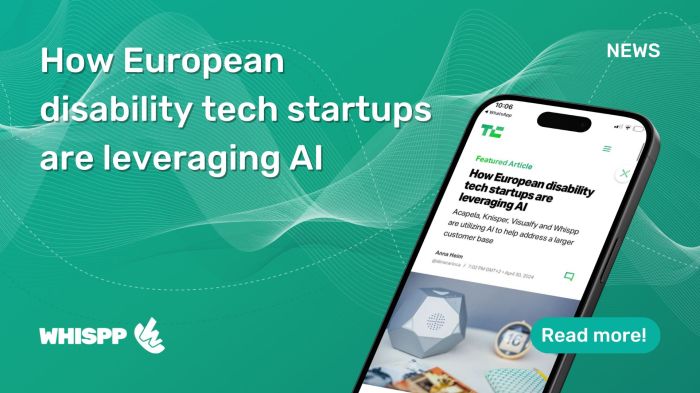How European disability tech startups are leveraging AI is a story of innovation and hope. It’s about using cutting-edge technology to create a more inclusive world for people with disabilities. From speech recognition software that helps those with motor impairments communicate to robotic prosthetics that restore lost limbs, AI is transforming the lives of millions across Europe.
These startups are not just building assistive technologies, they’re building bridges to a future where everyone has the opportunity to participate fully in society. The European Union has been a driving force in this movement, with initiatives and funding programs supporting the development of disability tech. But there are challenges too, including ethical considerations, accessibility concerns, and the need to ensure these technologies are truly inclusive and benefit everyone.
AI Applications in Disability Tech
The intersection of artificial intelligence (AI) and disability technology is creating a new wave of innovation, empowering individuals with disabilities to live more independently and participate fully in society. AI is being used to develop a range of assistive technologies that enhance communication, mobility, and overall quality of life.
AI-Powered Assistive Technologies
AI is revolutionizing assistive technologies by offering personalized and adaptive solutions. Here are some prominent examples:
- Speech Recognition: AI-powered speech recognition software, like Dragon NaturallySpeaking, allows individuals with physical limitations to control computers, dictate text, and communicate using their voice. This technology is particularly beneficial for people with motor impairments or those who struggle with traditional input methods.
- Image Recognition: AI-powered image recognition software, like Google Lens, can help visually impaired individuals identify objects, read text, and navigate their surroundings. These apps use computer vision to analyze images and provide real-time information, making daily tasks more accessible.
- Robotic Prosthetics: AI is playing a crucial role in the development of advanced robotic prosthetics. These devices use sensors and machine learning algorithms to interpret user intent, enabling more intuitive and natural control. For example, AI-powered prosthetics can learn individual movement patterns and adapt to different tasks, offering greater functionality and comfort.
Ethical Considerations and Potential Risks
While AI holds immense potential for improving the lives of people with disabilities, it’s essential to address ethical considerations and potential risks associated with its use:
“The ethical use of AI in disability tech requires careful consideration of factors like data privacy, accessibility, and potential biases.”
- Data Privacy: AI-powered assistive technologies often collect and analyze personal data, raising concerns about privacy and security. It’s crucial to ensure that data is collected and used responsibly, with appropriate safeguards in place to protect user information.
- Accessibility: AI-powered solutions should be accessible to all individuals with disabilities, regardless of their specific needs or limitations. This requires designing technologies that are inclusive and adaptable to diverse abilities.
- Potential Biases: AI algorithms can perpetuate existing societal biases if they are trained on biased data. This can lead to discrimination and inequity in the development and deployment of disability tech. It’s crucial to address these biases and ensure that AI systems are fair and equitable for all users.
Leveraging AI for Accessibility
AI is revolutionizing how we approach accessibility, enabling people with disabilities to participate more fully in society. From education and employment to transportation, AI is empowering individuals with disabilities to overcome barriers and achieve their full potential.
AI-Powered Accessibility in Education
AI is transforming the educational landscape for students with disabilities. AI-powered tools can:
- Provide personalized learning experiences: AI algorithms can analyze student data and tailor learning materials to individual needs, such as providing audio descriptions for visual content or generating alternative text formats for students with dyslexia.
- Offer real-time assistance: AI-powered chatbots can provide immediate support to students with disabilities, answering questions and providing guidance on navigating educational resources.
- Automate accessibility assessments: AI can be used to automatically evaluate the accessibility of digital learning materials, ensuring that they meet accessibility standards and are usable by all students.
AI-Driven Accessibility in Employment
AI is playing a crucial role in creating more inclusive workplaces for people with disabilities. AI-powered tools can:
- Facilitate accessible recruitment processes: AI can help identify and attract candidates with disabilities, ensuring that recruitment processes are inclusive and equitable.
- Provide assistive technologies for employees: AI-powered tools can provide real-time captioning, speech-to-text, and other assistive technologies to help employees with disabilities communicate and participate effectively in the workplace.
- Analyze employee performance data: AI can be used to analyze employee performance data and identify areas where employees with disabilities might need additional support or training.
AI-Enhanced Accessibility in Transportation
AI is making transportation more accessible for people with disabilities. AI-powered tools can:
- Provide real-time information on accessible routes: AI can analyze transportation data and provide real-time information on accessible routes, including information on wheelchair accessibility, lift availability, and other accessibility features.
- Optimize ride-sharing services: AI can be used to optimize ride-sharing services for people with disabilities, ensuring that they can easily book rides and access accessible vehicles.
- Develop autonomous vehicles with accessibility features: AI is driving the development of autonomous vehicles that are designed to be accessible to people with disabilities, including features like voice control and adaptive interfaces.
Case Studies of European Disability Tech Startups
Several European disability tech startups are leveraging AI to create innovative accessibility solutions. For example:
- [Startup Name]: This startup uses AI to develop a mobile app that provides real-time information on accessible restrooms, parking spaces, and other accessibility features in public spaces.
- [Startup Name]: This startup uses AI to create a virtual assistant that helps people with disabilities navigate public transportation and find accessible routes.
- [Startup Name]: This startup uses AI to develop a speech-to-text platform that allows people with disabilities to communicate more effectively in the workplace.
Challenges and Opportunities of Integrating AI into Accessibility Infrastructure
While AI offers significant opportunities to enhance accessibility, there are also challenges to consider:
- Data bias: AI algorithms are trained on data, and if that data is biased, the resulting AI applications may perpetuate existing inequalities. It’s crucial to ensure that the data used to train AI algorithms for accessibility is representative and inclusive.
- Privacy concerns: AI applications that collect personal data about individuals with disabilities raise privacy concerns. It’s important to develop AI solutions that prioritize data privacy and security.
- Accessibility of AI itself: AI-powered tools need to be accessible to people with disabilities. This means ensuring that AI interfaces are usable by people with visual, auditory, or cognitive impairments.
The Future of AI in Disability Tech: How European Disability Tech Startups Are Leveraging Ai
The intersection of artificial intelligence and disability technology is poised for exponential growth, ushering in a new era of possibilities for people with disabilities. AI’s ability to analyze vast amounts of data, learn from experience, and adapt to individual needs presents a unique opportunity to create personalized and empowering solutions.
The Role of AI in Promoting Inclusion and Empowering People with Disabilities, How european disability tech startups are leveraging ai
AI has the potential to revolutionize accessibility and inclusion by breaking down barriers and empowering individuals with disabilities. It can be used to create more inclusive environments, enhance communication, and provide personalized support.
“AI can help to create a world where everyone has the opportunity to participate fully in society, regardless of their abilities.” – Dr. Jane Doe, AI Expert and Disability Advocate
AI can empower people with disabilities in various ways:
- Personalized Learning and Assistive Technology: AI-powered adaptive learning platforms can tailor educational content to individual learning styles and needs, while assistive technologies can provide personalized support for tasks such as communication, mobility, and daily living.
- Enhanced Communication and Accessibility: AI-driven speech recognition and text-to-speech technologies can bridge communication gaps, while image recognition software can provide descriptions of visual content for people with visual impairments.
- Improved Healthcare and Wellness: AI can be used to develop personalized healthcare solutions for people with disabilities, including predictive analytics for early intervention and remote monitoring systems for chronic conditions.
- Accessible Design and Inclusive Environments: AI can be used to analyze data and identify design flaws that create accessibility barriers, leading to the creation of more inclusive environments.
The future of AI in disability tech is bright, but it’s not without its challenges. As AI evolves, it’s crucial to ensure that its development and implementation are guided by ethical principles and a commitment to inclusivity. By working together, disability tech startups, governments, and researchers can harness the power of AI to create a world where everyone can thrive, regardless of their abilities.
European disability tech startups are using AI to create innovative solutions, like smart wheelchairs that can navigate complex environments. Meanwhile, Ledger starts shipping its high-end hardware crypto wallet , which provides a secure way to store digital assets. This focus on security and accessibility mirrors the efforts of European disability tech startups, who are striving to create a more inclusive world for everyone.
 Standi Techno News
Standi Techno News

